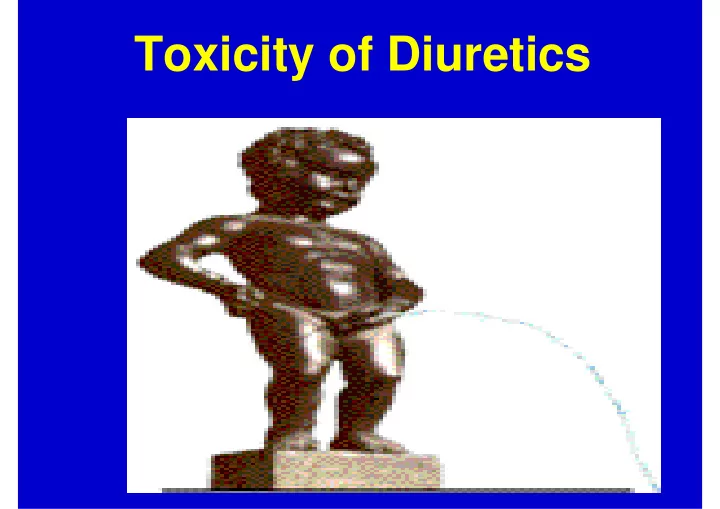

Toxicity of Diuretics
Outline 1. Sites of drug action 2. Osmotic diuretics 3. Carbonic anhydrase inhibitors 4. Thiazide diuretics 5. Loop diuretics 6. Potassium-sparing diuretics
Definitions Diuretic: substance that promotes the excretion of urine Natriuretic: substance that promotes the renal excretion of Na+
Renal Physiology Glomerular Filteration Tubular reabsorption proximal tubule loop of Henle thick ascending limb distal convoluted tubule collecting tubule • Tubular secretion • collecting tubules
Summary: Sites of Action
Osmotic Diuretics 1- do not interact with receptors or directly block renal transport 2- Activity dependent on development of osmotic pressure - Mannitol (prototype) - Urea - Glycerol - Isosorbide
Mechanism of Action Osmotic diuretics are not reabsorbed Increases osmotic pressure specifically in the proximal tubule and loop of Henle Prevents passive reabsorption of H2O Osmotic force solute in lumen > osmotic force of reabsorbed Na+ Increased H2O and Na+ excretion
Therapeutic Uses Mannitol drug of choice: non-toxic, freely filtered, non-reabsorbable and non-metabolized administered prophylatically for acute renal failure secondary to trauma, CVS disease, surgery or nephrotoxic drugs short-term treatment of acute glaucoma infused to lower intracranial pressure Urea, glycerol and isosorbide are less efficient can penetrate cell membranes
Toxicity increased extracellular fluid volume cardiac failure pulmonary edema hypernatremia hyperkalemia secondary to diabetes or impaired renal function headache, nausea, vomiting
Carbonic Anhydrase Inhibitors limited uses as diuretics Acetazolamide • prototype carbonic anhydrase inhibitor • developed from sulfanilamide (caused metabolic acidosis and alkaline urine)
Mechanism of Action inhibits carbonic anhydrase in renal proximal tubule cells carbonic anhydrase catalyzes formation of HCO3- and H+ from H2O and CO2 inhibition of carbonic anhydrase decreases [H+] in tubule lumen less H+ for for Na+/H+ exchange increased lumen Na+, increased H2O retention
Mechanism of Action
Therapeutic Uses used to treat chronic open-angle glaucoma aqueous humor has high [HCO3-] acute mountain sickness mostly used in combination with other diuretics in resistant patients
Toxicity rapid tolerance increased HCO3- excretion causes metabolic acidosis drowsiness fatigue CNS depression paresthesia (pins and needles under skin) nephrolithiasis (renal stones) K+ wasting
Thiazide and Thiazide-like Diuretics (Inhibitors of Na + -Cl - Symport) active in distal convoluted tubule Chlorothiazide (prototype) Hydrochlorothiazide Chlorthalidone Metolazone
Mechanism of Action inhibit Na+ and Cl- reabsorption in distal convoluted tubules increased Na+ and Cl- excretion weak inhibitors of carbonic anhydrase, increased HCO3- excretion increased K+/Mg2+ excretion decrease Ca2+ excretion
Whole Body Effects of Thiazides Increased urinary excretion of: • Na + • Cl - • K + • Water • - (dependent on structure) HCO 3 • • Mg++ (mild magnesuria) Reduced GFR • Reduced uric Acid excretion after chronic administration •
Therapeutic Uses Hypertension (due to decrease blood volume and peripheral resistance) Congestive heart failure Hypercalciuria: prevent excess Ca2+ excretion to form stones in ducts Osteoperosis Nephrogenic diabetes insipidus: reducing urine volume by up to 50 % Treatment of Li+ toxicity
Thiazide Use in Hypercalciuria - Recurrent Ca 2+ Calculi Thiazides promote distal • tubular Ca 2+ reabsorption Prevent “excess” • excretion which could form stones in the ducts of the kidney 50-100 mg HCT kept • most patients stone free for three years of follow- up in a recent study
Pharmacokinetics orally administered poor absorption onset of action in ~ 1 hour wide range of T 1/2 amongst different thiazides, longer then loop diuretics free drug enters tubules by filtration and by organic acid secretion
Thiazide Toxicity • Extracellular volume depletion • Hypotension Hypokalemia due to: • Increased availability of Na + for exchange at collecting duct • Volume contraction induced aldosterone release • • Hyponatremia • Hypochloremia • Hypomagnesemia • Metabolic alkalosis
Thiazide Toxicity Hyperuricemia • Direct competition of thiazides for urate transport • Enhanced proximal tubular reabsorption efficiency • Hyperglycemia • Decreased insulin release • Decreased serum K + • Decreased periphral glucose utilisation • hypercalcemia
Thiazide Toxicity - Hyperlipidaemia due to elevated plasma levels of LDL-Cholesterol Total Cholesterol Total triglycerides - Weakness - Paraesthesia - Impotence - Fatiguability - GIT: NVD
Loop Diuretics active in “loop” of Henle Furosemide (prototype) Bumetanide Torsemide Ethacrynic acid
Mechanism of Action enter proximal tubule via organic acid transporter inhibits apical Na-K-2Cl transporter in thick ascending loop of henle competes with Cl- binding site enhances passive Mg2+ and Ca2+ excretion increased K+ and H+ excretion in CCD inhibits reabsorption of ~25% of glomerular filtrate
Therapeutic Uses edema: cardiac, pulmonary or renal chronic renal failure or nephrosis hypertension hypercalcemia acute and chronic hyperkalemia
Pharmacokinetics orally administered, rapid absorption rapid onset of action bound to plasma proteins: displaced by warfarin, and clofibrate increase toxicity of cephalosporin antibiotics and lithium additive toxicity with other ototoxic drugs inhibitors of organic acid ion transport decrease potency (i.e. probenecid, NSAID’s)
Side Effects hypokalemia hyperuricemia metabolic alkalosis hyponatremia ototoxicity Mg2+ depletion
K+ sparing diuretics three groups steroid aldosterone antagonists spironolactone, eplerenone Pteridines triamterene Pyrazinoylguanidines amiloride
Mechanism of Action K+ sparing diuretics function in CCD decrease Na+ transport in collecting tubule Spironolactone competitive antagonist for mineralocorticoid receptor prevents aldosterone stimulated increases in Na+ transporter expression Triamterene/Amiloride organic bases secreted into lumen by proximal tubule cells inhibit apical Na+ channel
Therapeutic Uses primary hyperaldosteronism (adrenal adenoma, bilateral adrenal hyperplasia) congestive heart failure cirrhosis nephrotic syndrome in conjunction with K+ wasting diuretics
Pharmacokinetics Spironolactone orally administered aldactazide: spironolactone/thiazide combo Amiloride • oral administration, 50% effective • not metabolized • not bound to plasma proteins • Triamterine • oral administration, 50% effective • 60% bound to plasma proteins • liver metabolism, active metabolites
Side Effects hyperkalemia: monitor plasma [K+] spironolactone: gynecomastia triamterene: megaloblastic anemia in cirrhosis patients amiloride: increase in blood urea nitrogen, glucose intolerance in diabetes mellitus
Recommend
More recommend